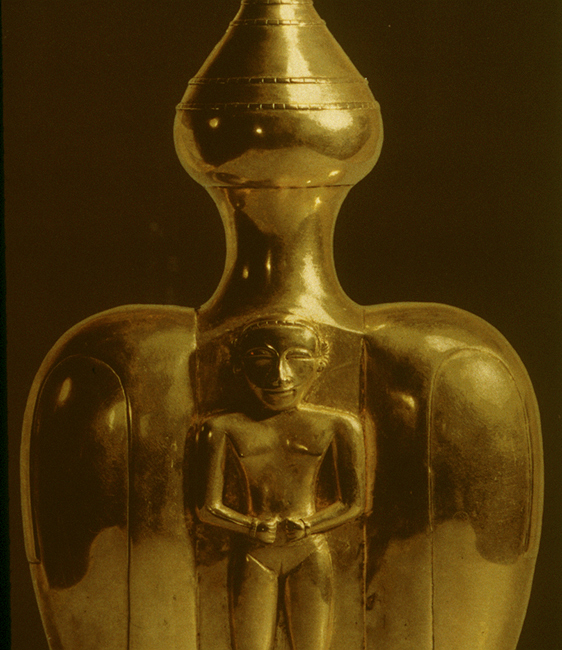Source: WTL course archives.
Object: This vase or vessel in pure gold is from the Quimbaya culture (200 BCE - 500 CE), in the Cauca Valley, Colombia. Although my image is cropped at the top and the bottom, the vessel is a little shorter than a foot high. The Cauca Valley is in the SW corner of Colombia around the city of Cali. It is situated at the extreme northern edge of the Inca empire when it expanded into this region at the end of the 15th century. (See: map of Colombia in: => Countries and Nations).
Comments: Quimbaya art developed in the early pre-Inca period in Colombia to a high degree in terms of extraordinary detail and perfection of skill. Among the major themes in their gold pieces are anthropormorphic figures--as in this example--helmets, and masks.
Myth of El Dorado. The Spaniards discovered the legend of El Dorado ("the golden man") when they arrived in present-day Colombia in the early sixteenth century. The legend existed among Colombian tribes, which told of a tribal chief who covered himself with gold dust and would dive into a mountain lake. The Colombian conquistador Gonzalo Jiménez de Quesada heard the legend from natives when he arrived in the Colombian highlands in 1537. Next, the conquistador Sebastián de Belalcázar took the story to Quito, Ecuador, thereby expanding the local story into a full-fledged myth about a place called El Dorado, which was said to be a city, a kingdom, and an inland empire. Next, Francisco Orellana and Gonzalo Pizarro went in search of this mythical place in 1541 when they undertook a disastrous journey across the Andes and down the entire length of the Amazon River. Not finding "El Dorado" in South America, Spanish conquistadors such as Francisco Vázquez de Coronado (1510-1544) searched the American Southwest as far inland as Colorado and Kansas in search of El Dorado and/or the Seven City of Gold of Cíbola (1540-1542).
Humanities Questions: What have you known about the myth of El Dorado? How has it survived into the twenty-first century? What humanities themes are illustrated by the gold vessel above and the myth of El Dorado?


